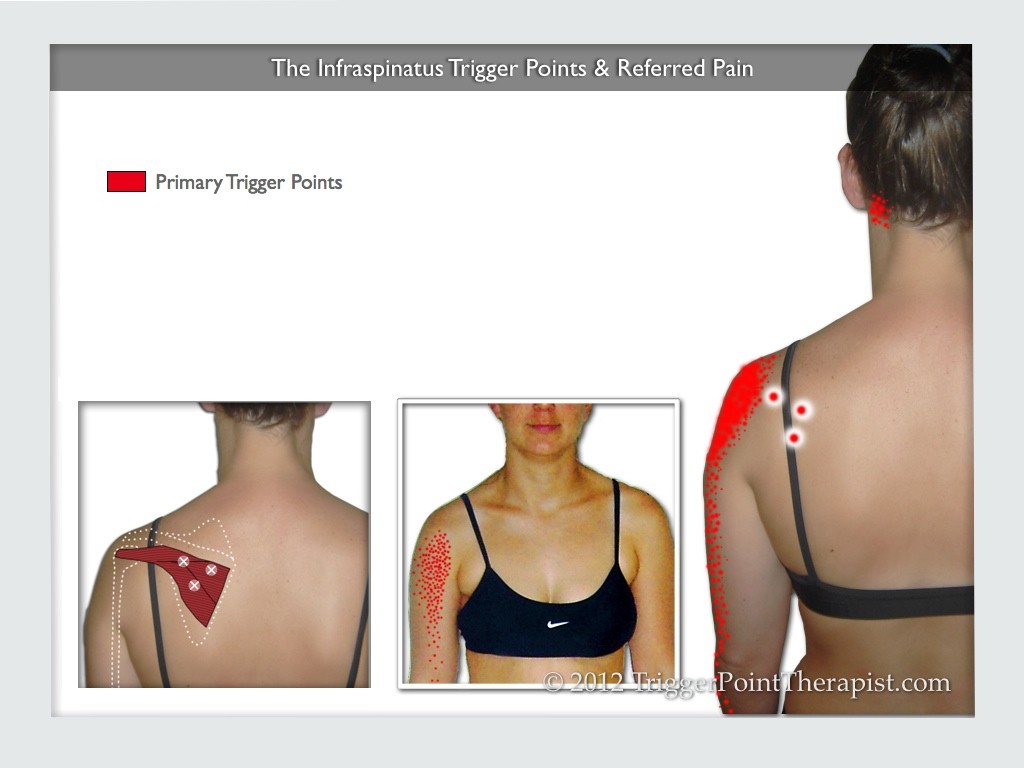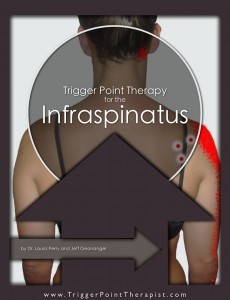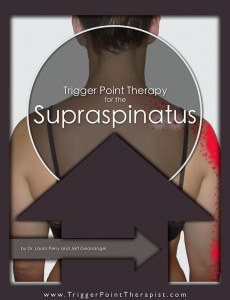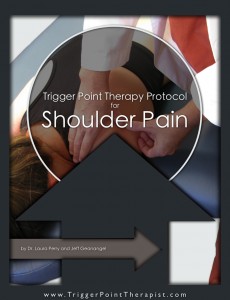Of all the shoulder pain trigger points that I treat in my practice, the infraspinatus trigger points are the most fun. Many patients think that I’m some kind of magician when I recreate the pain in the front of their shoulder by pressing into their shoulder blade. It’s not magic, of course, it’s just good myofascial pain science. If you are not familiar with the “magical” infraspinatus trigger points, please allow me the pleasure of introducing them to you in this post.
The Infraspinatus Muscle
Anatomy & Biomechanics: Let’s begin with a few brief anatomical and biomechanical details of this muscle. The infraspinatus muscle is found on the back of the shoulder blade and extends laterally to attach to the posterior aspect of the head of the humerus (upper arm) bone. This muscle has two important jobs:
- Lateral Rotation of the Arm: Contraction of this muscle rotates the arm to the outside at the shoulder. The simple act of raising your hand to wave hello to someone is a good example of the infraspinatus muscle at work (among others).
- Stabilize the Shoulder Joint: As one of the rotator cuff muscles, the infraspinatus contracts to stabilize the shoulder joint and keep the head of the humerus from slipping out of its socket during shoulder movement.
Syngeristic Muscles: The infraspinatus gets some help with its jobs from some of the other muscles in the shoulder girdle. The teres minor and deltoid (posterior head) muscles assist with lateral rotation of the arm, and the other rotator cuff muscles team up to assist with stabilizing the glenohumeral joint during various arm movements. The major antagonists to the infraspinatus are the subscapularis and pectoralis major muscles, both of which act to medially rotate the arm.
The Infraspinatus Trigger Points & Referred Pain
This muscle can contain three trigger points, arranged in a triangular pattern within the belly of the muscle. In my experience, the lower trigger point is the most common and most active in shoulder complaints. Referred pain from these trigger points is experienced deep in the front of the shoulder joint and along the upper arm. The pain may also spill down into the forearm and hand regions in severe cases.
Associated Trigger Points: Prolonged referred pain from these trigger points can activate the deltoid trigger points on the front of the shoulder. Referred pain in the forearm region may also activate wrist trigger points over time.
What Causes Infraspinatus Trigger Points?
As detailed in the “Comprehending the Cause of Trigger Points” article in the Trigger Point Therapy 101 Series, trigger points are activated (or reactivated) primarily by some form of muscular overload. In the infraspinatus muscle, overload can occur with any activity or event that requires a person to reach backwards with the arm or that keeps the arm raised to the front for long periods. Examples include:
- throwing a baseball or football
- forehand stroke in tennis
- walking a large dog that pulls on the leash
- long hours working at a computer keyboard with no elbow support
- bracing for a fall or slip by reaching behind the body
- long drives with the hands positioned on the top of the steering wheel
- beginning a new resistance training (weight lifting) routine will often overload any of the rotator cuff muscles
Infraspinatus Symptoms & Disorders
Patients/clients with active trigger points in this muscle will present with the following symptoms:
- Front of Shoulder Pain: This is the hallmark symptom for the infraspinatus trigger points. The pain often feels like it is deep within the shoulder joint, causing many clients to believe the shoulder joint itself is damaged.
- Inability to Reach Behind the Back: Clients will report that they are unable to reach behind their back to fasten a bra or get their wallet out of a back pocket. These movements require significant internal rotation of the shoulder, which stretches the tense muscle and aggravates the trigger points within it.
- Inability to Raise Arm Up To Head: Clients will report that they are unable to raise their arm up to wash their hair, brush their teeth, or even to bring food to their mouth while eating.
- Inability to Push With Arms: Clients will complain of shoulder pain when using their arms to push up out of a chair or when pushing up out of bed in the morning. Weight lifting exercises like the bench press, inclined bench press, and military press are nearly impossible with active infraspinatus trigger points.
- Shoulder Pain at Night: Infraspinatus trigger points can be a double-edged sword when trying to sleep on the side. If the client lays on the affected shoulder, the weight of the upper body can compress the trigger points and produce referred pain. If the client lays on the unaffected shoulder, the upper arm may hang down in front of the body and place the affected infraspinatus in a prolonged stretched state, aggravating the trigger points again. In severe cases, the client may be forced to sleep in a sitting position to prevent the pain from disturbing their sleep.
- Bicepital Tendonitis: The role that infraspinatus trigger points play in many cases of bicepital tendonitis deserves special mention here. This condition is characterized by tenderness and pain in the biceps brachii (front) region of the upper arm, and is prevalent in baseball pitchers, football quarterbacks, and tennis players. I haven’t had very many cases of bicepital tendonitis in my personal practice, but every case that I have seen was easily resolved by deactivating the Infraspinatus trigger points.
Treatment of the Infraspinatus Trigger Points
It is important for the therapist to check for and address any trigger point activity in the supraspinatus and deltoid muscles after treatment of the infraspinatus trigger points. Deltoid trigger points are likely to form in response to the referred pain from infraspinatus trigger points, and supraspinatus trigger points are nearly always coconspirators in rotator cuff issues.
For instructions on how to locate and release the infraspinatus trigger points you can purchase the Trigger Point Therapy for Infraspinatus Video.
Click on the image below to watch an excerpt from the Infraspinatus Trigger Points video on YouTube:
Related Articles:
- Shoulder Pain Trigger Points: The Multi-Headed Myofascial Pain Monster
- Supraspinatus Trigger Points: Treating the “Stubborn-atus” Trigger Points
- The Deltoid Trigger Points: What You See Is What You Get
Related Instructional Videos:





